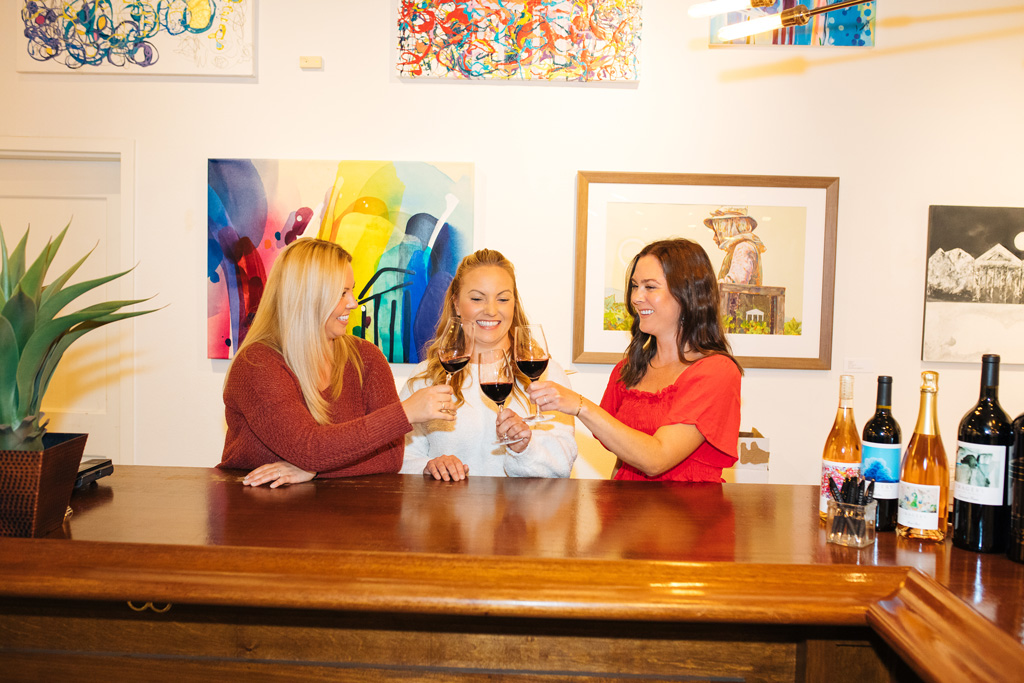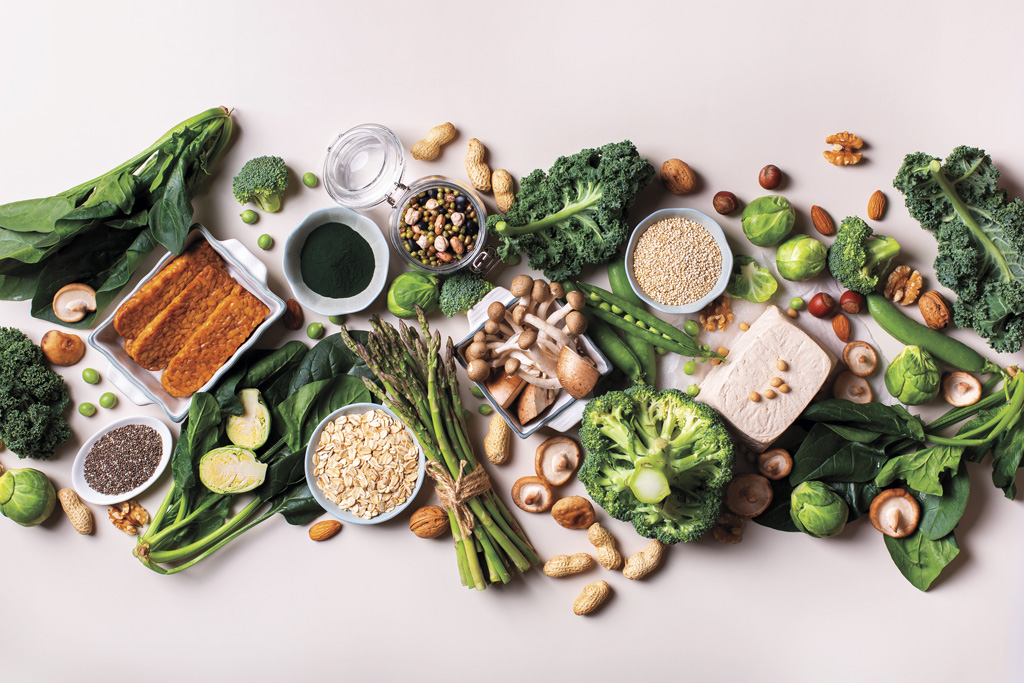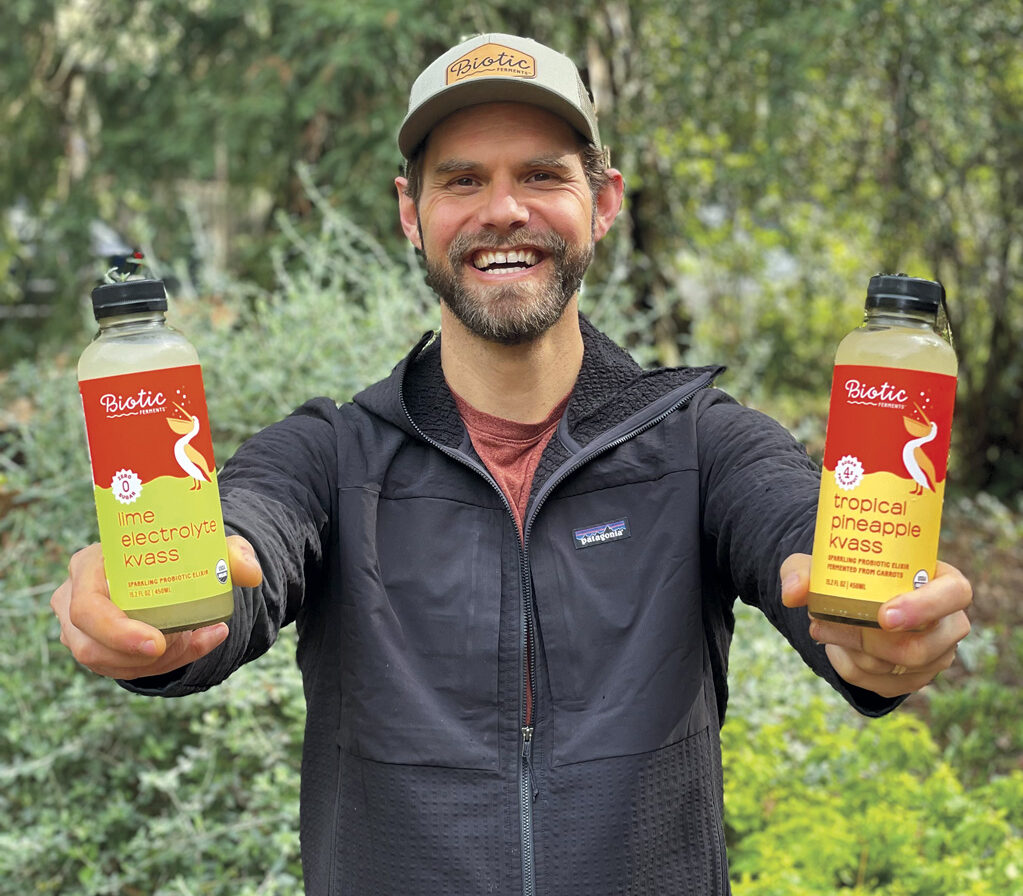Food & Drink
Marin Chef Shares His Recipe for Holiday Success
 Chef Gordon Drysdale (photo by Rachel Weill)
Chef Gordon Drysdale (photo by Rachel Weill)Gordon Drysdale’s regular customer isn’t the high-profile politico type; the chef’s Northern California restaurants tend to attract a different crowd. But on New Year’s Day several years back, he found himself catering to exactly that demographic— D.C. bigwigs. Hundreds of them. Drysdale, his wife and their sons were in Alexandria, Virginia, celebrating the holidays with his sister, brother-in-law and their kids. For the January 1 party, they needed a snack to serve. “They enjoy food, but …” Drysdale pauses. “My sister does not like to cook.”
Which is how the chef found himself in charge of truffled toasted cheese sandwiches, slowly spelling P’tit Basque over the phone to his shopping sister and brother-in-law before showing them how to grate the cheese, add truffle butter to slices of bread and toast everything on little electric griddles, then repeat the process tens of times.
“My brother-in-law, Steve, who had probably never held a spatula in his life, was just bursting with pride when he figured out that he himself, alone, could make truffled toasted cheese sandwiches,” Drysdale says with a laugh. “To see all these people who are so not in my world coming up to Steve saying ‘Oh, these sandwiches are amazing’ tickled me so much.”
Now those sandwiches remain a standby at that annual party, Drysdale’s attendance optional. It’s fitting that one of his favorite entertaining memories resulted in a tradition he’s no longer even a part of. Drysdale is very much of the “teach a man to fish” school, ever ready to share tips on how to make any event a success. And he has plenty of practice, having opened, headed or revitalized nearly a dozen restaurants in his decades-long career.
Spoiler alert: It’s not just the food that matters.
“For me, a great experience in a restaurant or home comes from lighting, attractive lighting,” Drysdale says. It all goes back to Auguste Escoffier, he explains. The famed French chef allegedly once said if women look beautiful in your restaurant, it will always be full. At home, Drysdale and his wife have landed on a soft orange glow as their signature hue. Little orange bulbs are peppered across the yard, and you’ll find some inside the house.
The music is important, too. Drysdale has been making tunes with this, that or the other instrument for decades; about once a month he hosts a music night under the big Meyer lemon tree in his backyard, and his bandmates are regulars at other casual get-togethers he arranges. But he always considers the crowd’s taste: since “music is essential for setting the tone for the experience to come,” he says, “if you’ve got a bunch of upbeat and lively people and you’re playing Bach concertos,” it might not go over so well.
And that’s what it all boils down to. “People want connection. People want comfort,” he says. Drysdale always tries to stack his invite lists with people who’ll mesh on different levels, to promote easy conversation. When everything comes together, it’s nothing short of magic. “I can recall the moment at Gordon’s House of Fine Eats about eight or nine months after we opened,” he says. “We had a fantastic band playing up on the mezzanine, the lighting was perfect, the food coming out was perfect, the roar of people enjoying themselves was perfect. I thought, ‘There, I did it. I’ve been striving to hit this kind of moment my entire life.’” Bustling restaurant or intimate gathering at home, those are the times you never forget.
A few recipes from Gordon’s personal holiday collection to help make your holiday gatherings as warm and memorable.
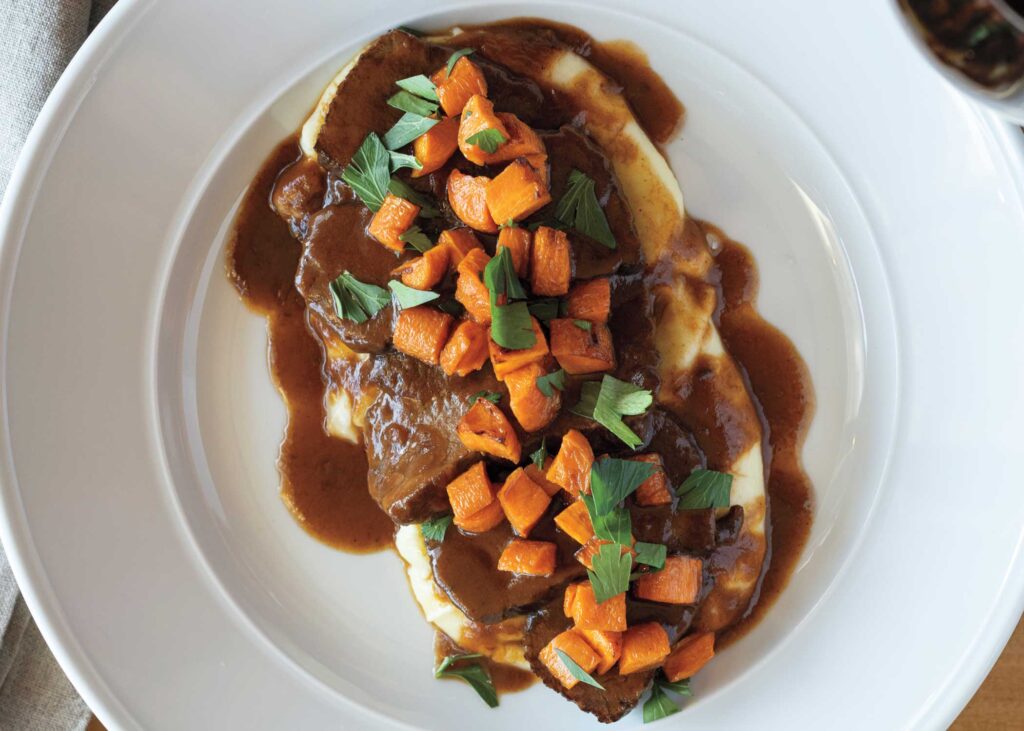
Balsamic Braised Short Ribs
Serves 8
“Braised short ribs — it’s a dish I frequently make on Christmas Eve,” Drysdale says, “with truffled mashed potatoes and wild mushroom ragout on top.” The extra touch: “Add truffle oil, and I like to add truffle salt as well, to your taste. The best truffle oil/salt I have found comes from Connie Green’s amazing Wine Forest Foods out of Napa.”
Ingredients
8 beef chuck flap portions (4 to 5 pounds)
1½ quarts (from about two, 28-ounce cans) chopped canned San Marzano tomatoes
1½ quarts medium diced onions
1 tablespoon fresh minced garlic
2 teaspoons finely minced fresh rosemary leaves
¾ cup balsamic vinegar
1½ quarts good chicken stock
2 bay leaves
To Make
- Lightly salt the short ribs and let sit out for a couple of hours, to come up to room temperature.
- Measure out 1½ quarts’ worth of San Marzano tomatoes and reserve the rest for other uses.
- When meat is room temperature, pat it dry and sear it in smoking oil. Caramelize well, but be careful; the meat burns easily. When beef is nicely browned on all sides, place in a roasting pan and set aside.
- Wipe out the dirty oil from the searing pan, but avoid scrubbing the pan unless it is terribly burned; the caramelization will add flavor to the braise.
- Heat fresh oil to smoking and caramelize onions. When nice and brown, add the garlic and rosemary and let cook 1 to 2 minutes. Add the balsamic vinegar, chicken stock and tomatoes, bring to a boil, then add seared beef.
- Bring all the ingredients in the pan to a final boil, cover and cook in a 275° F oven with no fan on for 2½ to 3½ hours; meat should be very tender when pierced with a knife, but not falling apart (that would be overcooked). Remove meat from the hot liquid to cool at room temperature for 30 minutes.
- Strain the braising liquid and set over a medium flame. When the mixture starts to boil, lower heat to a slow boil. Fat will start to accumulate; skim that off and strain into a tall, clear container, discarding foam and burnt particles but saving the clean fat.
- Reduce the braising liquid in the pan by about one-third — it should be full-flavored and tasty; if not, continue to reduce, but take care not to let it get too salty. Meanwhile, place reserved clean fat in a small pot and heat. When hot, add a small amount of flour and stir with a whisk to incorporate. Continue adding flour bit by bit until the fat-flour mix resembles wet sand. At this point cook over low-to-medium heat for 5 more minutes to make a roux.
- When the braising liquid is tasty and the roux is cooked, keep the liquid hot over a low-to-medium flame, stir a small amount of the roux into the liquid and let cook 1 to 2 minutes. Continue to stir in more roux bit by bit until the sauce is the texture of a nice gravy. Cook for 5 more minutes and strain through a fine strainer (a bouillon strainer if you have one).
- If you’re preparing this dish a day ahead (the ideal method), pour cleaned (thickened and strained) sauce over short ribs and chill uncovered until completely cold. When ready to serve the short ribs, slice, cover with more sauce, bring to a boil and heat over low heat until the meat is hot.
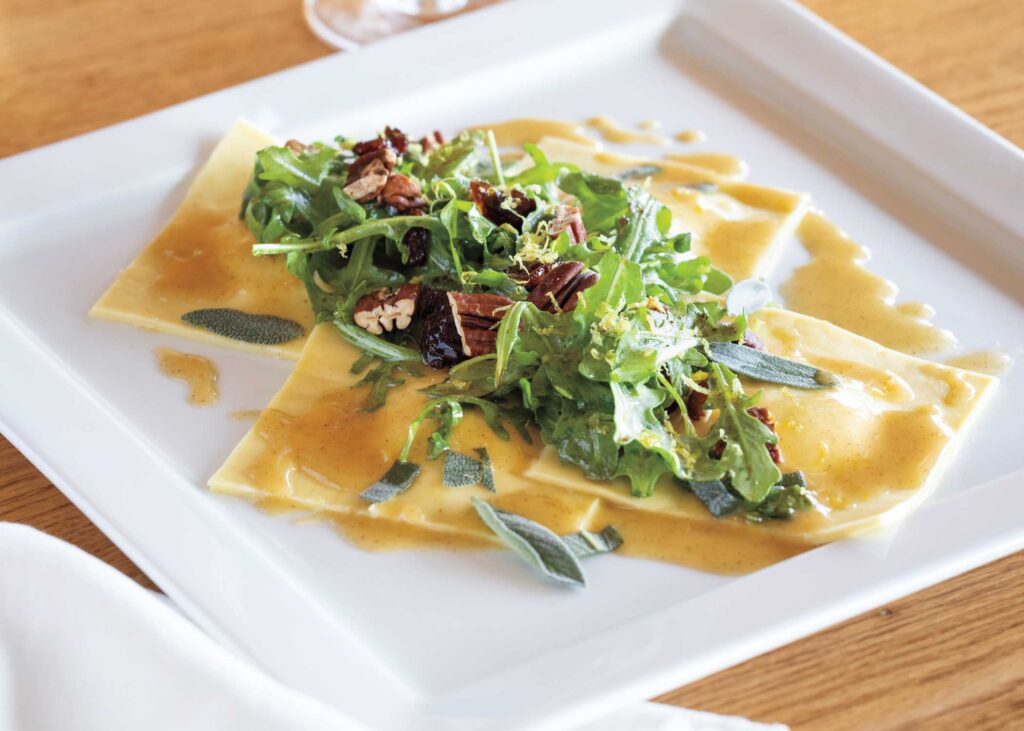
Butternut Ravioli With Sage and Brown Butter Sauce
Serves 8
“This is my butternut squash ravioli with a brown butter sauce with a fall salad on top. I buy wonton skins if I can find them so no one has to roll anything out (but lasagna sheets will do). Kind of a hack way of doing it that yields a really nice result, and it’s kind of a showstopper.”
Ingredients
thin lasagna sheets or wonton skins
ravioli filling (recipe below)
egg wash (beaten whole egg with a little touch of water)
brown butter sauce (recipe below)
sliced fresh sage leaves
lemon zest
wild arugula
toasted chopped pecans
chopped dried cranberries
aged balsamic
extra-virgin olive oil
To Make
- Open lasagna sheets or wontons package and cover them with a lightly moistened tea towel.
- Lay out 6 of the skins (or lasagna sheets cut into 3-inch squares) and place a spoonful of filling in the middle of each. With a clean paintbrush, place a half-inch rim of egg wash around the perimeter. Place a fresh skin on top and press down around the edges, leaving one little spot open in each to let excess air escape, then press down that edge as well. Seal the edges with light pressure from the tines of a fork.
- Lay out the ravioli one layer deep and either freeze or cover with a lightly moistened tea towel until ready to serve.
- Place a large pot of heavily salted water over a high flame and bring to a boil. Add the ravioli and cook until the edges are tender; then, with a skimmer or slotted spoon, carefully remove from the water onto a tray lined with another towel.
- Gently toss the hot ravioli with a bit of the warm brown butter sauce, place them on a plate, then sprinkle with thin ribbons of fresh sage and fresh lemon zest (use a microplaner to make these if you have one).
- Top with the salad of wild arugula, toasted pecans and dried cranberries tossed with aged balsamic and extra-virgin olive oil. Serve immediately.
Butternut Squash Ravioli Filling
Ingredients
6 cups roasted butternut or other full-flavored squash
6 cups whole-milk ricotta cheese
rice oil, for moistening
salt and fresh black pepper to taste
To Make
- Peel the butternut squash, slice it thin, toss with a little rice oil, salt and pepper and roast in a 350° F degree oven with the fan on (if your oven has one) until the thickest pieces are tender. A little deepening of color is OK, but don’t let it get too dark.
- Let the squash cool to room temperature; then either place in a food processor and process until smooth or mash by hand with a handheld blender or potato masher.
- Add ricotta and process or mash to thoroughly mix. Season to taste and either utilize or refrigerate immediately.
Brown Butter Ravioli Sauce
Ingredients
2 tablespoons fresh lemon juice
¾ cup sauvignon blanc or other crisp white wine
½ cup minced shallots
1 pound cold butter, cut in pieces
1 pound frozen browned butter (see instructions below), cut in pieces
1 tablespoon lemon zest (from roughly 2 lemons)
To Make
- Place lemon juice, wine and shallots in a small pot, bring to a boil and turn down to medium high. Reduce to a syrup.
- Over medium heat, add cold, unsalted butter, several pieces at a time, whisking continuously (being sure to add new butter before old butter completely melts into sauce). When the cold, unsalted butter is gone, continue with cold browned butter.
To make browned butter: Place cold unsalted butter in a pan over medium heat and cook, swirling occasionally, until color starts to show. Continue cooking until butter looks brown but not burned, pour into a metal pie tin or storage pan and place in the freezer. Wrap in plastic wrap once it’s frozen and store in freezer for up to several weeks. - When all butter is melted, remove pan from heat, whisk in lemon zest, adjust seasonings and hold sauce for service bain marie (covered, over warm water, to keep sauce from “breaking” or separating). Use a thermos preheated with hot water if you have one.

Brussels Sprouts Salad
Serves 4–6
“Thanksgiving is held at chef Bob Helstrom’s house and every year, my responsibility is a vegetable,” Drysdale says. “I had a very popular dish at Gordon’s House of Fine Eats called warm Brussels sprouts salad. Probably the most popular thing I’ve ever made. In the 20-something years since we first created the recipe, there have been literally millions of orders of this. It’s a signature dish. It’s a challenging dish, but so rewarding when you get it right.”
Ingredients
Salad:
½ pound slab bacon
2 tablespoons rice oil, plus 3 tablespoons for salad
2 medium onions, peeled and sliced
6 slices country-style bread, crusts removed, torn in ½-inch squares
2 tablespoons extra-virgin olive oil
6 large eggs
3 to 4 pounds brussels sprouts (about 40 good-size sprouts)
Vinaigrette:
3 tablespoons red wine vinegar
1 large clove garlic, minced
1 large shallot, minced
2 teaspoons fresh thyme leaves
½ cup rice oil (or other neutral vegetable oil)
To Make
- Early in the day, prepare the mise en place: cut bacon into half-inch squares and cook over low heat until almost crisp, drain off most of the fat and reserve. Heat 2 tablespoons of the rice oil until just smoking and cook sliced onions over medium-high heat until golden brown. Drain and set aside. Toss cubed bread with extra-virgin olive oil and toast in a 300° F oven until golden brown and crispy (about 20 to 25 minutes). Let cool to room temperature and set aside. Cover the eggs with cold water, bring to scald, and let sit in scalding water for 9 to 10 minutes, until yolk is firm but a little undercooked. Run cold water over eggs to stop cooking, peel, and cut into eighths. Cover and put in the refrigerator.
- Also early in the day, prepare your vinaigrette: soak the garlic, shallots and thyme in the vinegar for 45 minutes and then slowly whisk in the ½ cup rice oil. Season to taste with salt and pepper and reserve, covered, for service.
- While soaking and cooking the other items, clean the sprouts. Remove the first few dark leaves and discard. Cut off the stems and separate out the leaves one by one (this is not particularly fun). When you get to the light green center and can’t pull off the leaves you are done — you can save the heart for other uses.
- To cook the salad (finally!): in a large sauté pan heat remaining 3 tablespoons of rice oil until almost smoking and add leaves. Toss until wilted (about 3 minutes), season with salt and pepper, then add reserved onions and bacon and warm a little more until hot. When hot, add well-stirred vinaigrette, toss to distribute and taste for seasoning. Season with salt and pepper, add croutons and eggs, toss and serve.




